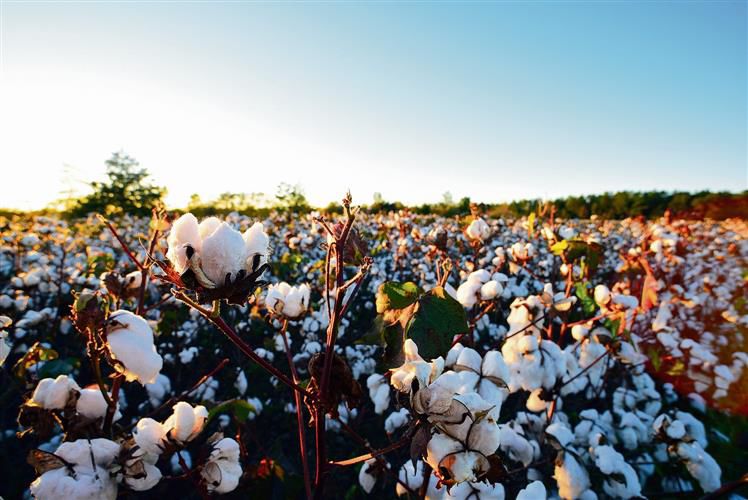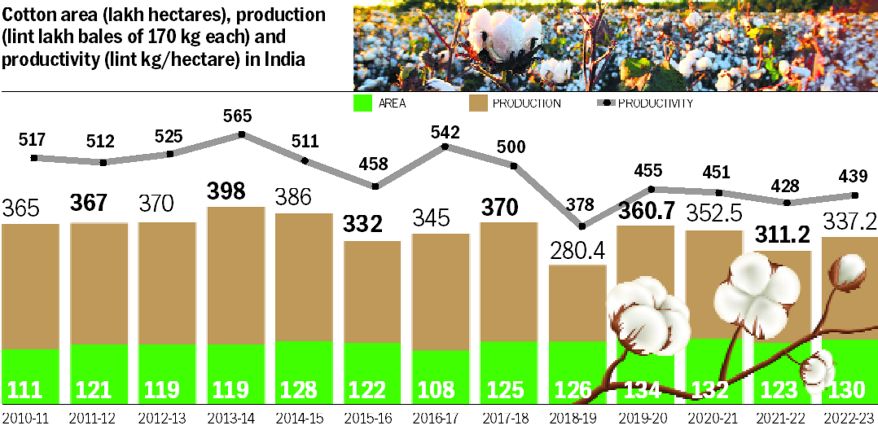
A decline in cotton production is hampering India’s efforts to maintain its leading position, which it achieved after the introduction of transgenic Bt cotton hybrids in 2002.
SS Chahal
A decline in cotton production is hampering India’s efforts to maintain its leading position, which it achieved after the introduction of transgenic Bt cotton hybrids in 2002. As per a report released in December last year by the Cotton Association of India, the production of 294.1 lakh bales (each of 170 kg) in 2023-24 was the lowest in the past 15 years and around 8 per cent less than that in the previous year. It has created a gap of 120 lakh bales between the Indian textile industry’s requirement and domestic production. As per government data, in the 2023 kharif season, cotton crop was sown on around 123.8 lakh hectares (ha), which was over 3 per cent less than in the previous year. Over the years, about 30 per cent yield reduction has occurred (it had reached a high of 565 kg/ha in 2013-14). Indian farmers cultivate cotton on about 38 per cent of the 330 lakh ha area in the world. The area, production and productivity fluctuated in monsoon-dependant southern (Telangana, Andhra Pradesh, Karnataka and Tamil Nadu) and central (Gujarat, Maharashtra and Madhya Pradesh) zones between 2012-13 and 2021-22. In the northern zone, during this period, Rajasthan raised its production from 17 to 25.97 lakh bales and area from 4.5 to 7.07 lakh ha, but with decreased productivity (down to 624 from 642 kg/ha). Haryana registered an increase of 81,000 ha area (from 6.14 to 6.95 lakh ha), but production and productivity declined from 26 to 20.43 lakh bales and 720 to 500 kg/ha, respectively. During these years, area in Punjab dropped to 3.04 from 4.8 lakh ha and production to 13.65 from 21 lakh bales, while productivity increased by 21 kg per ha.

Punjab could bring only 2.4 lakh ha under cotton in 2022-23; in the current year (2023-24), it further declined to 1.75 lakh ha. The state fell short by 45 per cent in achieving the moderate target of 3 lakh ha set by the government, resulting in a 45 per cent decrease in yield as compared to the previous year. Several factors have diminished the glitter of the ‘white gold’, which is considered to be an appropriate alternative to high water-requiring rice crop under the crop diversification plan — but it is happening the other way round. Heavy pre-sowing irrigation is a must for getting good germination and establishment of plants; this is a limitation in rainfed southern and central zones. In the northern irrigated zone, sufficient canal water is crucial. However, even such a provision, ensured in April-May last year in Punjab, could not restore farmers’ confidence, signifying the importance of factors other than water availability at the time of sowing.
The cotton seed market is estimated at $0.82 billion this year, of which about 95 per cent is in the hands of private companies that cater to 95 per cent of the area occupied by transgenic hybrids. The spurious seed market has flourished across the states. The South Asia Biotechnology Centre found in 2017 that around 8 per cent of the 450 lakh cotton seed packets sold in the states had spurious content. The menace needs stringent measures so as to supply genuine seeds to farmers. The use of portal and mobile app Sathi (Seed Traceability, Authentication and Holistic Inventory) can be of great help in seed traceability to curb this illegal practice.
The crop is attacked by scores of sap-sucking, defoliator and bollworm insects. Whitefly, jassids, aphids, thrips, mealybug and miribug can assume alarming proportions due to prolific breeding, if not managed in a timely manner. Whitefly devastated the crop in 2015-16. The breakdown of resistance offered by the Bt toxins in first and second-generation Bt cotton to pink bollworm (PBW) after around 2009 and 2014, respectively, poses a challenge to scientists to explore seeds with new resistance to this lepidopteran pest, which is capable of causing 50-60 per cent yield loss.
About 45 per cent of the pesticides are used for pest control at various stages of crop growth. Studies have revealed that in Punjab, pesticide use in cotton accounts for 27 per cent of the total cost of production. Sadly, fake products impede pest management. India’s fake pesticide market is expanding at the rate of 20 per cent, while the genuine one is growing at 12 per cent annually. Freely supplied to ignorant farmers at critical times, fake pesticides prove to be a double whammy, just like spurious seeds. They lead to futile, repeated application, adding to the cost of cultivation without any benefit; they also cause environmental pollution. It is imperative to plug loopholes, ensure strict enforcement of the law, accelerate traceability using the Sathi app, strengthen the farm advisory system, enhance farmers’ awareness, minimise dependence on pesticides and adopt IPM (integrated pest management) technologies.
The available IPM modules generally include avoiding excessive use of nitrogenous fertilisers, fumigation and acid-delinting of seeds, field sanitation, intercropping, crop rotation, removal of alternative and collateral hosts, planting of barrier, border and trap crops, uprooting and destroying of infested plants, regular monitoring, using pheromone traps, sticky traps and yellow pan for determining initial pest build-up and checking ETL (economic threshold level) before deciding on need-based, judicious and safe application of recommended pesticides. There is a need to adopt the sowing of ‘refuge’ (isogenic non-Bt version of Bt hybrids), popularise the mating disruption technique and remove pest-harbouring trash from ginneries. It would be worthwhile to practise the ‘sterile insect release strategy’, for which drones can be immensely useful (as a result, the US was declared a PBW-free country in 2018). At the same time, boosting research efforts to bring precision in location-specific IPM modules under changing climatic conditions for effectively dealing with new virulence of the pests can arrest the slide in cotton cultivation.
The author is a former VC, Maharana Pratap University of Agriculture & Technology, Udaipur
Send your feedback to [email protected]
Join Whatsapp Channel of The Tribune for latest updates.



























